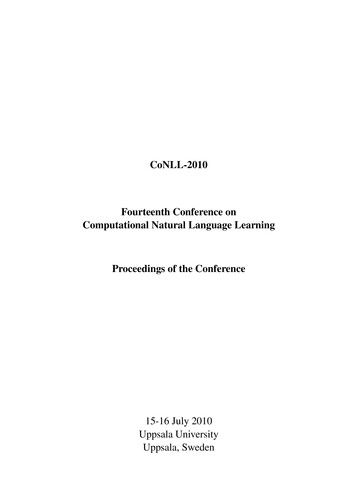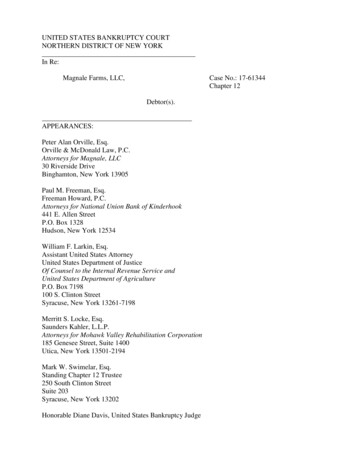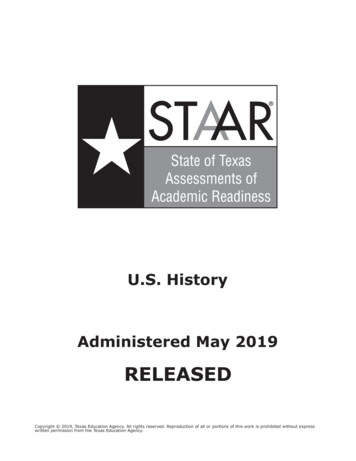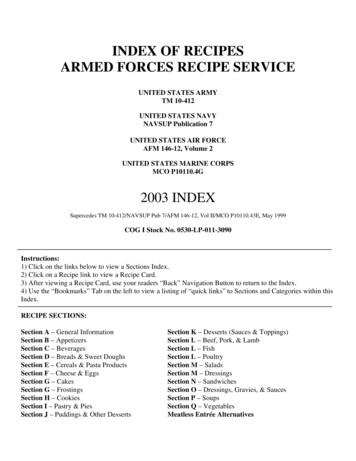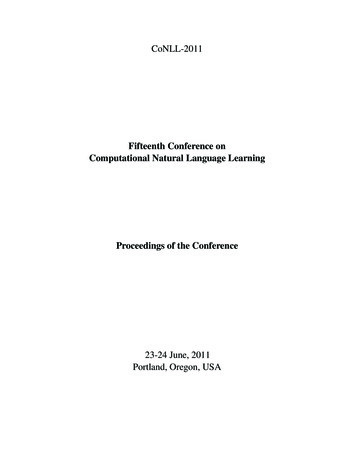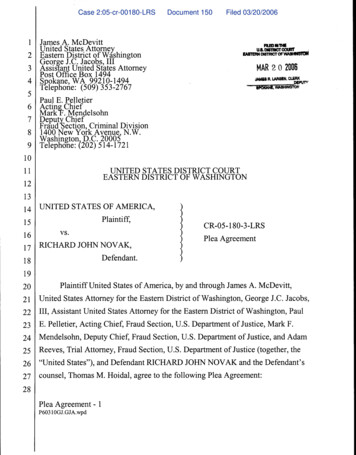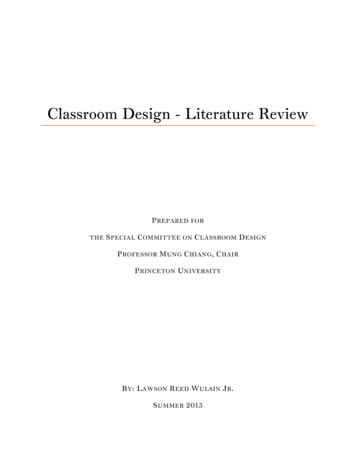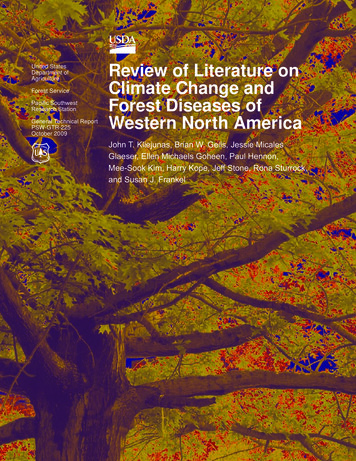
Transcription
United StatesDepartment ofAgricultureForest ServicePacific SouthwestResearch StationTUDE PARTREGeneral Technical ReportPSW-GTR-225October 2009MENT OF AGRI C U LReview of Literature onClimate Change andForest Diseases ofWestern North AmericaJohn T. Kliejunas, Brian W. Geils, Jessie MicalesGlaeser, Ellen Michaels Goheen, Paul Hennon,Mee-Sook Kim, Harry Kope, Jeff Stone, Rona Sturrock,and Susan J. Frankel
The U.S. Department of Agriculture (USDA) prohibits discrimination in all its programs andactivities on the basis of race, color, national origin, age, disability, and where applicable, sex,marital status, familial status, parental status, religion, sexual orientation, genetic information,political beliefs, reprisal, or because all or part of an individual’s income is derived from anypublic assistance program. (Not all prohibited bases apply to all programs.) Persons withdisabilities who require alternative means for communication of program information (Braille,large print, audiotape, etc.) should contact USDA’s TARGET Center at (202) 720-2600 (voiceand TDD). To file a complaint of discrimination, write USDA, Director, Office of Civil Rights,1400 Independence Avenue, SW, Washington, DC 20250-9410 or call (800) 795-3272 (voice)or (202) 720-6382 (TDD). USDA is an equal opportunity provider and employer.AuthorsJohn T. Kliejunas is a retired regional forest pathologist, U.S. Department ofAgriculture, Forest Service, Pacific Southwest Region, 1323 Club Drive, Vallejo,CA 94592. Brian W. Geils is a research plant pathologist, U.S. Department ofAgriculture, Forest Service, Rocky Mountain Research Station, Southwest ForestScience Complex, 2500 South Pine Knoll Drive, Flagstaff, AZ 86001. JessieMicales Glaeser is a research plant pathologist, U.S. Department of Agriculture,Forest Service, Northern Research Station, One Gifford Pinchot Drive, Madison,WI 53726. Ellen Michaels Goheen is a forest pathologist, U.S. Department ofAgriculture, Forest Service, Forest Health Protection, Southwest Oregon ForestInsect and Disease Service Center, 2606 Old Stage Road, Central Point, OR 97502.Paul Hennon is a research forest pathologist, U.S. Department of Agriculture,Forest Service, Forestry Sciences Laboratory, 2770 Sherwood Lane, Suite 2A,Juneau, AK 99801. Mee-Sook Kim is a plant pathologist, U.S. Department ofAgriculture, Forest Service, Rocky Mountain Research Station, 1221 South MainStreet, Moscow, ID 83843 and Assistant Professor, Department of Forest Resources,Kookmin University, Seoul, Korea 136-702. Harry Kope is the provincial forestpathologist, Forest Practices Branch, British Columbia Ministry of Forests andRange, 9th Floor, 727 Fisgard St., Victoria, BC, Canada V8W 1R8. Jeff Stone isa research professor, Department of Botany and Plant Pathology, Cordley Hall2082, Oregon State University, Corvallis, OR 97331. Rona Sturrock is a researchscientist, forest pathology, Natural Resources Canada, Canadian Forest Service,Pacific Forestry Centre, 506 West Burnside Road, Victoria, BC, Canada V8Z 1M5.Susan J. Frankel is a plant pathologist, U.S. Department of Agriculture, ForestService, Pacific Southwest Research Station, 800 Buchanan Street, West AnnexBuilding, Albany, CA 94710-0011; sfrankel@fs.fed.us.
AbstractKliejunas, John T.; Geils, Brian W.; Glaeser, Jessie Micales; Goheen, EllenMichaels; Hennon, Paul; Kim, Mee-Sook; Kope, Harry; Stone, Jeff;Sturrock, Rona; Frankel, Susan J. 2009. Review of literature on climatechange and forest diseases of western North America. Gen. Tech. Rep.PSW-GTR-225. Albany, CA: U.S. Department of Agriculture, ForestService, Pacific Southwest Research Station. 54 p.A summary of the literature on relationships between climate and various typesof tree diseases, and the potential effects of climate change on pathogens inwestern North American forests is provided. Climate change generally will leadto reductions in tree health and will improve conditions for some highly damagingpathogens. Sections on abiotic diseases, declines, canker diseases, root diseases,Phytophthoras, foliar diseases, stem rusts of pine, mistletoes, and wood decayspresent some examples of potential disease effects with predicted climate change.The effects of climate change on hosts, pathogens, and their interaction will havenumerous, mostly adverse, consequences to forest ecosystems.Keywords: Climate change, forest pathogens, forest tree diseases.
Contents1Introduction2Background2Climate Change3Climate Change and Disturbance in Forest Ecosystems5Effects of Climate Change on Forest Pathogens6Abiotic Diseases8Declines10Canker Diseases12Root Diseases14Phytophthora Species16Foliar Diseases19Stem Rusts of Pine23Mistletoes26Wood Decays28Summary of Climate Change and Forest ts32English Equivalents33References
Paul HennonReview of Literature on Climate Change and Forest Diseases of Western North AmericaDecline of yellow-cedar on western Chichagof Island in southeast Alaska.IntroductionThe evidence is clear that one of the features that characterizesthe world’s climate is instability We now come to the present century and find general agreementthat during the first 40 or more years the warming trend has notonly been continuing but possibly accelerating As we explore what these changes in long-term weather mean withrespect to forest diseases, we must realize that while mean rises ordrops in temperature or moisture are important, the extremes whichvary with these means may be more important.—George Hepting, 1963This literature review is the result of the “Climate Change and Western ForestDiseases” project sponsored by the U.S. Department of Agriculture ForestService (USDA FS) Western Wildland Environmental Threat Assessment Center(WWETAC) and the Pacific Southwest Research Station (PSW). The project buildson a June 2007 workshop on climate change and forest insects and diseases held byWWETAC (Beukema and others 2007) and a workshop in October 2007 that wassponsored by the USDA FS, WWETAC, and PSW in cooperation with the 2007Western International Forest Disease Work conference.1
GENERAL TECHNICAL REPORT PSW-GTR-225The objectives of the Climate Change and Western Forest Diseasesproject are to:1. Provide high-quality information on climate change and forest diseasesto land managers and forest pathologists.2. Integrate forest pathology and forest pathologists into climate changepolicy, management, and science.3. Identify forest diseases that threaten ecosystems undergoing rapidclimate change.4. Determine needs for research, management, and extension to addressfuture climate change and forest disease issues.This literature review is intended to inform managers, decisionmakers,scientists, and others about the potential effects of occurring and predictedclimate change on forest pathogens and forest pathogen/host interactions.BackgroundClimate ChangeThe world’s climate is changing (Houghton and others 1996, IPCC 2007, Wigley1999). During the past 100 years, average global temperatures have risen by about0.8 C. Although Earth’s climate has fluctuated for millions of years (Jackson andOverpeck 2000, Russell 1941), the current rate of warming has been unprecedentedover the last millenium (IPCC 2007, Mann and others 1999). In the conterminousUnited States, average temperature has risen by 0.5 C, and precipitation hasincreased by 5 to 10 percent (National Assessment Synthesis Team 2000). Inaddition, the variance in temperature and precipitation is increasing. Further, thefrequency and severity of extreme weather effects may be increasing (Hopkin andothers 2005).Causes of climate change include changes in atmospheric concentrations ofgreenhouse gases and aerosols, and changes in land cover and solar radiation. Theconcentration of carbon dioxide, the most important anthropogenic greenhouse gas,has risen dramatically since preindustrial times. Models of the carbon cycle projectthat the concentration of carbon dioxide will increase from 379 parts per million(ppm) in 1995 to 540 to 970 ppm by 2100 (IPCC 2001, 2007). Even if humansources of greenhouse gas emissions were stabilized, warming would continuefor centuries owing to time lags associated with climate processes and feedbacks(IPCC 2007).2
Review of Literature on Climate Change and Forest Diseases of Western North AmericaAverage global temperature is projected to increase from 1 to 6 C from 1990to 2100. Increases across much of the United States may be even greater (Houghtonand others 2001). Increases in winter temperature and more frequent droughts arepredicted throughout much of the Western United States under most climate changemodels (USDA Forest Service 2003). Precipitation may increase slightly in wintermonths, but the duration of seasonal heat and drought is likely to increase (USDAForest Service 2003). Projections for the Pacific Northwest (Mote and others 2003),based on output from eight global circulation models, are illustrative. Temperaturein the Pacific Northwest is projected to increase from 0.5 to 2.5 C by 2020 andfrom 1.5 to 3.2 C by 2040. Precipitation across the region is projected to increaseexcept during summer. In British Columbia, snowmelt may occur earlier and morerapidly, with a reduction in summer streamflows (Hamann and Wang 2006).There is consensus that the direct and indirect effects of climate change onforest dynamics may be profound (Aber and others 2001, Ayres and Lombardero2000, Dale and others 2001). Climate change will affect the geographic distributionof vegetation types, ecosystem processes such as primary production, and thedistribution and abundance of individual species of trees and other plants (Malcolmand Pitelka 2000, Malcolm and others 2006). In British Columbia, the projectedfuture climate may result in the disappearance of subboreal and montane climateregions, resulting in the loss of suitable habitat for many ecologically andcommercially important species of conifers (Hamann and Wang 2006).Climate Change and Disturbance in Forest EcosystemsForest ecosystems are affected both directly and indirectly by natural disturbancesincluding but not limited to fire, drought, insects and pathogens, hurricanes,windstorms, and ice storms (McNulty and Aber 2001). The distribution, frequency,and severity of these disturbances is affected by changes in climate (Dale andothers 2000, Joyce and others 2001, Walther and others 2002). When disturbancesexceed a forest’s ability to maintain a stable state (that is, its resilience), fundamental changes in forest structure and function are inevitable (Drever and others 2006,Gunderson 2000). Impacts of disturbances and thus of climate change are seenover a broad spectrum of spatial and temporal scales (Peterson 2000). As climatechanges, outbreaks of insects and diseases in forests may become more common(McNulty and Aber 2001). Disease reflects interaction among a susceptible host, avirulent pathogen, and environmental conditions that support the pathogen. Therefore, any climatic change that increases host susceptibility to a pathogen or resultsin an environment more suitable for the pathogen will result in increased incidenceof disease.When disturbancesexceed a forest’sability to maintaina stable state (thatis, its resilience),fundamental changesin forest structure andfunction are inevitable.3
GENERAL TECHNICAL REPORT PSW-GTR-225Some species of trees can evolve rapidly in response to changes in temperature(Jump and others 2006). However, it is unclear how trees will be affected byinteractions among changes in climate and disturbances such as fire, insects, andpathogens (Anderson and others 2004). Determinants of forest response to insectsand pathogens include the category, host specificity, and aggressiveness of thepathogen and the phytosociology and functional importance and distinctivenessof the host (Ayres and Lombardero 2000, Harrington 2002, Logan and others2003, Lovett and others 2006).The forested area annually impacted by insects andpathogens in the United States is approximately 45 times the area affected by fire(20 400 000 and 450 000 ha, respectively), with an economic impact almost fivetimes as great (Dale and others 2001, Logan and others 2003, insect and diseasedata from USDA 1997). The USDA FS (2004) estimated that the area of insect- anddisease-caused tree mortality increased from about 1.2 million ha in 1997 to about4.9 million ha in 2003. Because dead trees serve as fuel for catastrophic wildfires,insects and pathogens often play key roles in the occurrence and severity of theforest’s second greatest disturbance agent, fire (Bergeron and Leduc 1998, Heptingand Jemison 1958).Forests already stressed by high tree density (overstocking), pathogens, orclimatic conditions such as drought may not survive additional climatic stress(Winnett 1998). Forests in southern California provide an example. In the early2000s, a severe drought, the worst in the recorded history of the region, in combination with stress induced by overstocking, dwarf mistletoe (Arceuthobium spp.),and annosus root disease (caused by Heterobasidion annosum), predisposedconifers to bark beetle attack. The resulting bark beetle epidemic and subsequenttree mortality provided fuel for wildfires that occurred in late October and earlyNovember 2003. More than 300 000 ha of brush and timber burned during 1 week.Twenty-six lives and 3,360 homes were lost. The fires caused more than 2.5 billionin damage (Keeley and others 2004) and dramatically altered ecosystem structureand function. Similarly, recent mortality of pinyon pine (Pinus edulis Engelm.)across 12 000 km2 of the Southwestern United States was attributed to the stressof pathogens and drought that left trees susceptible to infestation by bark beetles(Breshears and others 2005).4
Review of Literature on Climate Change and Forest Diseases of Western North AmericaEffects of Climate Change on Forest PathogensMost plant pathogens are stronglyinfluenced by environmentalconditions and the vigor of the host.Climate change will directly affectthe pathogen, the host, and the interaction between them, resulting inchanges in disease impacts (Brasier2005, Burdon and others 2006).Global climate change ultimately isexpressed at the microclimatic scale,the scale at which plant pathogensreproduce, disperse, and infecttheir hosts (Waggoner 1965). Hostcondition, thus susceptibility topathogens, also is affected by cyclesand extremes of temperature andmoisture (see Ayers and Lombardero 2000, Hopkin and others 2005).The following sections summarize the literature on relationshipsbetween climate and various typesof tree diseases, and the potentialeffects of climate change on pathogens in western North Americanforests. Rather than summarizingthe entire body of literature on theeffects of weather (temperature andmoisture) on the host, pathogen, anddisease, each section presents someexamples of potential disease effectswith predicted climate change.Key points:Although we are uncertain how specific forest pathogens willrespond to climate change, existing knowledge allows us todraw some general inferences. The distribution of pathogens and diseases, and theirinfluence on the status and trend of forests, will change.Increases in temperature may allow some diseases toexpand their latitudinal and elevational ranges. The influence of pathogens on the status and function of forestsmay change coincident with changes in species composition and climate. If managers facilitate migration of treespecies to new locations, we should expect new diseasesto affect those trees. Climate change will alter the epidemiology of plant diseases. Prediction of disease outbreaks will be more difficultin periods of rapid climate change and unstable weather. In a rapidly changing climate, the rate at which pathogensevolve and overcome host resistance may increase. Because abiotic factors such as temperature and moistureaffect host susceptibility to pathogens and pathogenaggressiveness, changes in interactions between bioticdiseases and abiotic stressors may represent the mostsubstantial effect of climate change on plant diseases. Climate change may facilitate invasion by new nonnativepathogens. New epidemics may occur as a result. Many pathogens currently are limited by wintertemperature, and seasonal increases in temperature areexpected to be greatest during winter. Accordingly, bothoverwintering survival of pathogens and disease severityare likely to increase. The effects of climate change on individual plant diseaseswill depend on the ecosystem and climate conditions.5
GENERAL TECHNICAL REPORT PSW-GTR-225Kim Camilli, California Dept. ofForestry and Fire ProtectionAbiotic DiseasesKim Camilli, California Department of Forestry and Fire ProtectionAgents of abiotic forest disease include, but are not limited to, air pollutants;extremes of temperature, precipitation, and water availability; and nutrientdeficiencies. Abiotic environmental factors affect plant disease in several ways.First, abiotic diseases can result from direct effects of the environment on thehost. Direct effects of environmental extremes (for example, drought, low or hightemperatures) are generally negative (Desprez-Loustau and others 2006). Anincrease in average temperature may accelerate photochemical reaction rates andincrease the concentration of water vapor in the lower atmosphere, which likely willincrease concentrations of ozone (Sitch and others 2007). OzoneKey point:reduces the ability of plants to sequester carbon dioxide and canincrease tree susceptibility to root disease (James and others 1980a, Drought stress exacerbates1980b).the damage to trees fromSecond, factors such as temperature and moisture affect hostmany pathogens, particularlysusceptibility and pathogen aggressiveness. For example, severityfacultative parasites.of the foliage disease Swiss needle cast (caused by Phaeocryptopusgaeumannii) in western Oregon is strongly correlated with winter temperature,which affects growth of the pathogen (Manter and others 2005). Water stress wasassociated positively with the severity of effects of Sphaeropsis sapinea on pines(Bachi and Peterson 1985; Blodgett and others 1996, 1997; Paoletti and others2001). Drought in northwesternAlberta in the 1960s and 1980sdecreased resistance of aspen(Populus spp.) stands to fungalcankers and wood-boring insects(Hogg and others 2002). In theSouthwestern United States, widespread mortality of pinyon (Pinusmonophylla Torr. & Frem.) andjuniper (Juniperus osteosperma(Torr.) Little and J. occidentalisHook.) is associated with severalyears of drought; drought, insects,and disease are responsible forlocal pinyon mortality rates thatcan approach 100 percent (Shawand others 2005).Salt damage on Jeffrey pine, Pinus jeffreyi.6
Third, abiotic factors also functionas predisposing, inciting, or contributingagents in tree declines (Manion 1991).Stress depletes a tree’s carbohydratereserves, increasing its vulnerability toinsects and pathogens (Wargo and Haack1991).The incidence of abiotic diseasesassociated with environmental extremes isexpected to increase as climate changes, asare diseases caused by interactions betweenbiotic and abiotic agents (Boland and others2004). Mortality of seedlings and saplingsis a likely consequence of severe drought.Mature trees are less vulnerable to waterlimitation because they have deep roots andsubstantial reserves of carbohydrates andnutrients. However, severe or prolongeddrought may render even mature trees lessresistant to insects or disease (Hanson andOzone injury on blue elderberry, causing interveinal necrosis.Weltzin 2000, Joyce and others 2001).Tree mortality in response to drought will become more common as temperature increases. Of particular concern is regional-scale mortality of overstory trees,which rapidly would alter land cover and ecosystem function. These changes wouldlast for decades (Breshears and others 2005, Folke and others 2004).A variety of pests, pathogens, and parasites can infect trees stressed by climaticextremes (Jurskis 2005). An increased incidence of summer drought would maketrees more vulnerable to attack by fungi whose activity is dependent on host stress,particularly root pathogens, wound colonizers, and latent colonizers of sapwood(Broadmeadow 2002, Desprez-Loustau and others 2006, Lonsdale and Gibbs 2002,Redfern and Hendry 2002). Pathogens that are more likely to infect stressed hostswill benefit from the effects of heat and drought on forest and urban trees (Bolandand others 2004, Schoeneweiss 1975).Changes in climate including increased temperature, increased evapotranspiration, and extreme weather events may create unusually high levels of stress in foreststands (Columbia Mountains Institute of Applied Ecology 2005, Sturrock 2007).Forests already stressed by high tree density, pathogens, or atmospheric conditionsmay not survive the additional climatic stress (Winnett 1998).Don DuriscoeReview of Literature on Climate Change and Forest Diseases of Western North America7
GENERAL TECHNICAL REPORT PSW-GTR-225James WorrallDeclinesPhil KempTree decline is characterized by a slow and progressive deterioration in conditionor vigor, decreased growth accompanied by branch dieback on mature trees, and acomplex etiology often involving abiotic and biotic factors (Manion 1991, Manionand Lachance 1992). Long-term predisposing factors (such as unfavorable site,age, climate, and genetics) decrease the resistance of trees to short-term incitingfactors (such as frost and defoliation). Inciting factors weaken the trees and, inconjunction with contributing factors (such as opportunistic pathogens), ultimatelykill the trees.Decline and mortality of western white pine (Pinus monticolaKey point:Dougl. ex D. Don), referred to as pole blight, was observed in the The incidence and magniInland Empire region of the Pacific Northwest in the 1930s andtude of forest declines are1940s. The decline appeared to be associated with the predisposingpredicted to increase as localfactor of shallow soils that held little moisture and the contributingpopulations of trees arefactors of canker pathogens and root deterioration from Armillariastressed by climate change.root rot (Leaphart 1958, Wellington 1954). Climate records indicatedthat between 1916 and 1940, regional precipitation was lower andtemperature higher than during the past 280 years (Leaphart and Stage 1971). Thus,drought was an inciting factor in the pole blight, with shallow soils the predisposingfactor and secondary fungi contributing factors.Aspen stand nearly completely dead owing to sudden aspen decline, Mancos-Dolores RangerDistrict, San Juan National Forest, Colorado.8
Review of Literature on Climate Change and Forest Diseases of Western North AmericaMortality of yellow-cedar (Chamaecyparis nootkatensis (D. Don) Spach),known as yellow-cedar decline, occurs on about 200 000 ha in southeast Alaskaand British Columbia (Hennon and others 2005, Wittwer 2004). Despite muchstudy, no biotic causes could be identified for the decline, which began in thelate 19th century (Hamm and others 1988, Hansen and others 1988, Hennon1990, Hennon and others 1986, Hennon and McWilliams 1999, Shaw and others1985). The distribution of yellow-cedar decline is associated with low snowpackin winter and spring, which is consistent with the assumption that snow protectsyellow-cedar. Seasonal air and soil temperatures consistently were correlatedwith yellow-cedar decline, but saturated soils, acidic soils, aluminum toxicity, andcalcium deficiency were not. The areas with greatest yellow-cedar mortality hadtemperatures that were higher in the spring and summer, lower in winter, and hadgreater daily ranges. Snow delays soil warming. Without the snow’s protection,yellow-cedar roots were damaged during warm spring days interspersed withovernight frost (Schaberg and others 2007). Thus, the inciting factor of climatechange (climate warming) is hypothesized to be the primary cause of yellow-cedardecline (Beier and others 2008; Hennon and others 2006, 2008).Sudden aspen decline, the premature death of aspen (Populus spp.) stands,recently has begun to occur in southern Colorado, Utah, and Nevada. The declineis characterized by severe, rapid branch dieback and crown thinning. Widespreadand severe drought from 2000 to 2005 may have caused stress in aspens, particularly in mature stands at lower elevations, reducing the trees’ resistance to secondary infections and infestations. The decline is associated with predisposing factors(low elevations, south to west aspects, open stands, and mature trees), incitingfactors (hot, dry conditions), and contributing factors (secondary insects and pathogens including Cytospora canker [caused by Valsa sordida Nitschke], aspen barkbeetle [Trypophloeus populi Hopkins, and Procryphalus mucronatus LeConte],poplar borer [Saperda calcarata Say], and bronze poplar borer [Agrilus liragusBarter and Brown]) (Forest Health Management 2008, Worrall and others 2008).9
GENERAL TECHNICAL REPORT PSW-GTR-225Tom Gordon, University of California-DavisCanker DiseasesCankers are diseases that result in death of sections on branches or main trunksof trees. Cankers are usually caused by the infection of bark tissues by plantpathogens. Although numerous canker pathogens are capable of attacking vigorous trees, many canker-causing fungi are more likely to cause damage to treeswith heat and drought stress (Schoeneweiss 1975, 1981). Outbreaks or epidemicsof these stress-related canker diseases often follow water stress and freezingstress (Schoeneweiss 1981). Most published studies refer to a positive associationbetween drought and disease, or to synergistic effects of drought and disease.Most canker diseases are caused by facultative parasites such as Botryosphaeria,Sphaeropsis, Cytospora, and Biscognauxia (Hypoxylon) (Desprez-Loustau andothers 2006).Botryosphaeria dothidea attacks a wide range of hosttrees, but causes serious damage only to those that areKey point:weakened or under environment stress (Ma and others 2001). Many stem canker and diebackDrought stress and winter injury have been associated withpathogens are more successfulincreased infection and canker expansion of B. dothideawhen attacking stressed trees.(Brown and Hendrix 1981).Water and drought stress, andSeverity of Sphaeropsis shoot blight, caused by the fungustherefore the incidence of cankerSphaeropsis sapinea (Fr.) Dyko & B. Sutton, consistently hasand dieback pathogens, willbeen associated with water stress (Bachi and Peterson 1985;increase as climate changes.Blodgett and others 1996, 1997; Paoletti and others 2001).Cankers caused by Septoria musiva Peck on inoculated water-stressed trees weresignificantly larger than those on nonstressed trees (Maxwell and others 1997).The distribution of pitch canker (caused by Fusarium circinatum Nirenberg& O’Donnell) is limited by low temperatures. Inoculation trials during winteryielded low infection rates (Inman and others 2008). Increases in minimumwinter temperature may increase the range of the pathogen in the Sierra Nevadaand elsewhere (Battles and others 2006).The pathogen Biscogniauxia mediterranea (De Not.) Kuntze (Hypoxylonmediterranea) historically was widespread in oak woodlands in theMediterranean, with a northern range limit of southern Tuscany. However, inrecent years, the pathogen has been detected on damaged oaks in Slovenia (Jurcand Ogris 2006), and it is likely to continue moving north as climate warms.10
Review of Literature on Climate Change and Forest Diseases of Western North AmericaTom Gordon, University of California-DavisClimate change may increase the incidence of many canker diseases. Mostcanker-causing fungi benefit from heat and drought stress to forest and urbantrees (Boland and others 2004, Broadmeadow 2002, Lonsdale and Gibbs 2002,Schoeneweiss 1975). For example, incidence of Sphaeropsis sapinea on pinesis likely to increase as drought becomes more common. The incidence of someother canker pathogens, such as Thyronectria austro-americana (Speg.) Seeleron honeylocust (Gleditsia triacanthos L.) and Cryphonectria cubensis Bruner onEucalyptus spp., may decrease as climate changes. Incidence of these pathogensis associated with high rainfall, and their hosts display some resistance to droughtstress (Despres-Loustau and others 2006).Closeup views of a resin-soaked pitch canker lesion caused by Fusarium circinatumon Monterey pine, Pinus radiata, from a tree in coastal California near Monterey.11
GENERAL TECHNICAL REPORT PSW-GTR-225Phytosphere ResearchRoot DiseasesTree stress is one of the major factors affecting the incidence and spread of rootdiseases. Several root pathogens, in particular Heterobasidion annosum (Fr.) Bref.and Armillaria spp., both of which are major pathogens of western forest conifers,are more aggressive when hosts are stressed. Climate change could increase theincidence and spread of root pathogens like these if host trees become stressed. Inaddition, climate change could alter the relative fitness of various mycorrhizal fungiand other microbes that currently suppress root disease. The protective effects ofmycorrhizae may change in response to changes in soil temperature or moisture(Broadmeadow 2002).Some reports suggest that hot and dry conditions typical of prolonged drought will increase incidence and spread of root diseases inKey point:forests. However, it is difficult to predict how diverse root diseases will Simultaneous increasesbe affected by different climate scenarios. Although empirical datain temperature andare limited, a rise in atmospheric carbon dioxide and increased growthdecreases in precipitaof tree roots may result in an increase in severity or frequency of roottion are likely to increasedisease. More extensive root systems would increase the probability ofincidence and spread ofinvasion (O’N
This literature review is intended to inform managers, decisionmakers, scientists, and others about the potential effects of occurring and predicted climate change on forest pathogens and forest pathogen/host interactions. Background Climate Change The world’s climate is changing (Houghton and others 1996, IPCC 2007, Wigley 1999).Author: John T. Kliejunas, Brian W. Geils, Jessie Micales Glaeser, Ellen Michaels Goheen, Paul E. Hennon, Me.



